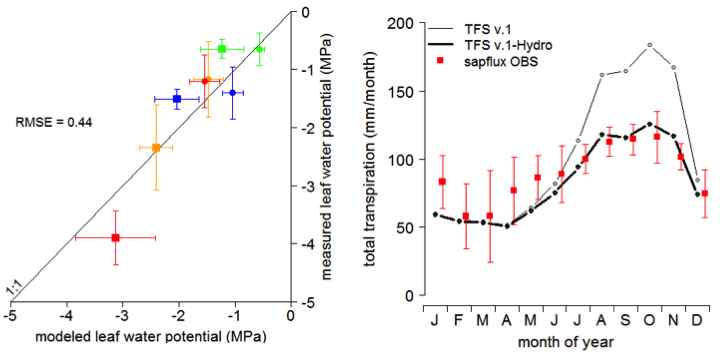A trait-based plant hydraulics model for tropical forests, developed for use within size-structured models
The Science
We developed a trait-based plant hydraulics model for tropical forests. It successfully predicts how individual trees in a forest vary in water status based on their size, canopy position and hydraulic traits, which improved simulations of total ecosystem transpiration.
The Impact
A substantial amount of diversity in tropical forests can be represented by a reduced set of dimensions. This sub-model can be used in conjunction with other demographic ecosystem models to predict how forest composition evolves under a changing climate.
Summary
We developed a plant hydraulics model for tropical forests based on established plant physiological theory, in which all parameters of the constitutive equations are biologically-interpretable and measureable plant hydraulic traits (e.g., the turgor loss point, hydraulic capacitance, xylem hydraulic conductivity, water potential at 50% loss of conductivity for both xylem and stomata, and the leaf:sapwood area ratio). Next we synthesized how plant hydraulic traits coordinate and trade-off with each other among tropical forest species. We first show that a substantial amount of trait diversity can be represented in the model by a reduced set of trait dimensions. We then used the most informative empirical trait-trait relationships derived from this synthesis to parameterize the model for all trees in a forest stand. The model successfully captured individual variation in leaf and stem water potential due to increasing tree size and light environment, and also improved simulations of total ecosystem transpiration. Collectively, these results demonstrate the importance of plant hydraulic traits in mediating forest transpiration and overall forest ecohydrology. When used in conjunction with other demographic ecosystem models, this modeling approach can be used to predict how forest composition evolves under a changing climate.
Contact: Brad Christoffersen, Los Alamos National Laboratory, bradley@lanl.gov, 505-665-9118
Funding
This research was supported in part by the European Union Seventh Framework Program under the project AMAZALERT, and by the Next-Generation Ecosystem Experiments (NGEE-Tropics) project, funded by the U.S. Department of Energy, Office of Biological and Environmental Research. Funding was also contributed by the Los Alamos National Laboratory LDRD.
Publications
Christoffersen, et al. “Linking hydraulic traits to tropical forest function in a size-structured and trait-driven model (TFS v.1-Hydro).” Geoscientific Model Development Discussions (2016). doi:10.5194/gmd-2016-128.
Related Links
doi:10.5194/gmd-9-4227-2016-supplement
doi:10.15486/NGT/1256473
doi:10.15486/NGT/1256474